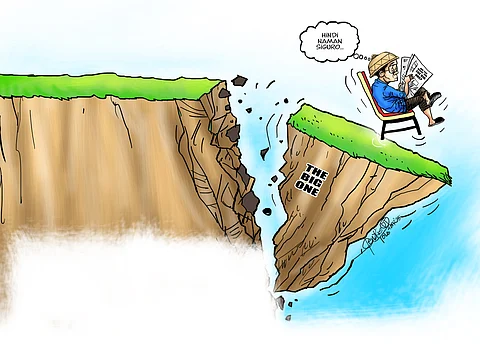
- NEWS
- the EDIT
- COMMENTARY
- BUSINESS
- LIFE
- SHOW
- ACTION
- GLOBAL GOALS
- SNAPS
- DYARYO TIRADA
- MORE

For years, the specter of “The Big One” — a catastrophic earthquake caused by the movement of the West Valley Fault — has loomed over Metro Manila.
Experts have long warned that a magnitude-7.2 tremor could kill tens of thousands, displace millions, and cause unparalleled destruction to infrastructure. While government agencies and disaster risk reduction groups insist that the country is prepared, a closer look at our disaster preparedness reveals a more complicated reality.
The Philippine Institute of Volcanology and Seismology (Phivolcs) and the National Disaster Risk Reduction and Management Council (NDRRMC) have been proactive in raising awareness about “The Big One.”
Regular earthquake drills, particularly the annual Metro Manila Shake Drill, aim to instill a culture of readiness. The Department of Public Works and Highways (DPWH) has also mandated structural retrofitting for older buildings and stricter compliance with the National Building Code.
Evacuation plans and emergency response protocols have been established, with some local government units (LGUs) setting up command centers and stockpiling relief goods.
However, readiness on paper does not always translate to reality. Many government buildings, schools, and hospitals remain structurally vulnerable.
A report by Phivolcs has pointed out that a significant number of residential and commercial buildings in Metro Manila do not comply with modern earthquake-resistant standards. Corruption and lax enforcement of building codes have led to subpar construction, which could spell disaster when the fault line finally moves.
Filipinos are no strangers to natural disasters, given the country’s location along the Pacific Ring of Fire. Despite this, there remains a significant gap between awareness and actual preparedness.
Many households do not have emergency kits or evacuation plans. Informal settlers, who make up a large portion of Metro Manila’s population, live in poorly built structures that are unlikely to withstand a strong quake.
Moreover, misinformation and complacency are rampant. Some residents believe that minor earthquakes are signs of “pressure release” that will prevent a major quake — an unscientific myth that downplays the real risk. Even among the educated, there is a tendency to dismiss disaster preparedness as an issue to be dealt with “later.”
One of the biggest concerns surrounding “The Big One” is whether Metro Manila’s infrastructure can handle the aftermath.
Studies predict that bridges, roads, and elevated highways will collapse, isolating parts of the city. Access to hospitals and emergency services will be severely limited. Fire hazards, due to ruptured gas lines, could trigger secondary disasters. The Philippine Red Cross and private response teams are ready to assist, but their resources pale in comparison to the potential scale of devastation.
While efforts have been made to prepare for “The Big One,” the Philippines is still far from being truly ready: Preparedness should go beyond drills and government rhetoric — it requires consistent enforcement of building codes, widespread public education, and a long-term commitment to resilience.
Until then, Metro Manila remains a ticking time bomb, waiting for a catastrophe that will test the nation’s true level of preparedness.
